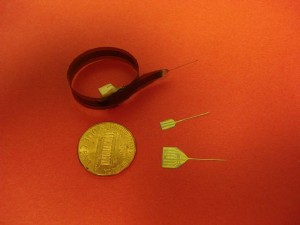Oct 15 2008
Engineering researchers at the University of Arkansas have developed a neural probe that demonstrates significantly greater electrical charge storage capacity than all other neural prosthetic devices. More charge storage capacity means the device can stimulate nerves and tissues with less damage and sense neural signals with better sensitivity.
 Neural probes with nanowire electrodes.
Neural probes with nanowire electrodes.
Findings of the project were published in Nanotechnology 2008 and will be included in an upcoming issue of IEEE Transactions on Biomedical Engineering.
The neural probe, made of gold and iridium oxide nanowires grown vertically on a polymer or titanium substrate, will improve the function and reliability of neural prosthetic devices. It has also displayed superior biocompatibility and mechanical strength compared to similar silicon structures.
“Our goal is to develop functional systems that can simultaneously stimulate nerves or muscle cells and record physiological changes in the human body,” said Hargsoon Yoon, research assistant professor in the College of Engineering and lead researcher on the project. “Our approach can minimize cell damage and even provide higher electrode efficiency than commonly used electrodes.”
Needle probes are used as neural prostheses to help improve quality of life for patients with severe impairments. Current clinical applications of neural prosthetics include cochlear and retinal implants, cardiac pacing and defibrillation, restoration of urinary bladder function, functional electrical stimulation in paralyzed individuals and deep brain stimulation for people with Parkinson’s disease and Tourette syndrome.
The research team, based at the university’s Center for Wireless Nano-, Bio- and Info-Tech Sensor and Systems, developed probes that integrate free-standing, “hetero-structured” nanowires. Hetero-structured means the nanowires have an inner core and outer layer. Made of gold, the inner-core nanowires were grown vertically on titanium and polymer substrates. The outer, functional layer, made of iridium oxide, provides charge storage capacity for neural signal sensing and stimulation.
Engineering researchers at the University of Arkansas have developed a neural probe that demonstrates significantly greater electrical charge storage capacity than all other neural prosthetic devices. More charge storage capacity means the device can stimulate nerves and tissues with less damage and sense neural signals with better sensitivity.
Findings of the project were published in Nanotechnology 2008 and will be included in an upcoming issue of IEEE Transactions on Biomedical Engineering.
The neural probe, made of gold and iridium oxide nanowires grown vertically on a polymer or titanium substrate, will improve the function and reliability of neural prosthetic devices. It has also displayed superior biocompatibility and mechanical strength compared to similar silicon structures.
“Our goal is to develop functional systems that can simultaneously stimulate nerves or muscle cells and record physiological changes in the human body,” said Hargsoon Yoon, research assistant professor in the College of Engineering and lead researcher on the project. “Our approach can minimize cell damage and even provide higher electrode efficiency than commonly used electrodes.”
Needle probes are used as neural prostheses to help improve quality of life for patients with severe impairments. Current clinical applications of neural prosthetics include cochlear and retinal implants, cardiac pacing and defibrillation, restoration of urinary bladder function, functional electrical stimulation in paralyzed individuals and deep brain stimulation for people with Parkinson’s disease and Tourette syndrome.
The research team, based at the university’s Center for Wireless Nano-, Bio- and Info-Tech Sensor and Systems, developed probes that integrate free-standing, “hetero-structured” nanowires. Hetero-structured means the nanowires have an inner core and outer layer. Made of gold, the inner-core nanowires were grown vertically on titanium and polymer substrates. The outer, functional layer, made of iridium oxide, provides charge storage capacity for neural signal sensing and stimulation.